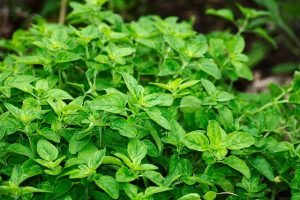
If there are a few herbs to grow in the garden then growing oregano is one of them – a must-have. We love it for its green, herbal, pungent aroma. Pizzas and pasta dishes are not complete without them.
Oregano is related to Marjoram and is often colloqially called Pot Marjoram, Unlike Marjoram, Origanum vulgare as it is scientifically called is a perennial herb and a native of the Mediterranean region especially Greece. The plant grows to just over two feet tall and has oval green-greyish leaves. The flowers are a light mauve, white with flashes of purple. It is one of many species of oregano.
In colder climates it will probably grow more as an annual but does withstand snow and frost, coming back year after year. A great herb too for attracting bees. Most plants lose their flavour after three years although we have one which has been growing for 20 years and still continues to perform its flavour miracle.
Uses
The flavour of oregano is generally described as pungent and slightly but not overfussy with spice. There is some bitterness too which counters sweeter fruits that it is added to such as tomato.
Ideal herbs for anything Italian -sprinkling onto pizza, spaghetti and a standard of Marinara sauces. The herb is versatile enough for beef or lamb stews, gravies, salads, soups, even tomato juice.
In the medical sense, the herb was referred to by Culpepper for general use especially in protecting meat from spoilage.
Sowing
Start seed off in the greenhouse from February to May. Fill a small pot with some seed compost and sow just a few seeds on the surface. Cover with a light layer of sieved compost, water and place in a propagator to germinate. When seedlings are large enough to handle, prick three out into an 8cm (3in.) pot of multi-purpose compost.
An alternative form of growing is to sow seeds directly into a prepared bed in the garden or in containers.
Growing On
Keep the soil and potted plants watered regularly but do not overwater as the roots will rot. Keep plants compact by trimming growth after flowers fade in summer, then give pot-grown plants a boost by applying a liquid fertiliser.
Cut back dead stems to the base in winter. Plants do not like to be too wet in winter, so place pots in a sheltered spot and raise onto pot feet to allow excess water to drain away. For a winter supply of leaves, lift plants in autumn, pot them up and place them in a well lit spot under cover.
Plant
Grow indoors until early summer or until all danger of frost has passed, then plant in a sunny, sheltered spot in well-drained soil. Alternatively, plant into a 15cm (6in) pot filled with multi-purpose compost.
Use as a companion plant to attract hover flies to eat aphids.
[Please note we are an affiliate marketing partner and will make a sales commission if you purchase any items through our affiliate links. To make a purchase please click on a picture or direct link. Please read our affiliate disclosure].
Purchase your Oregano seeds here